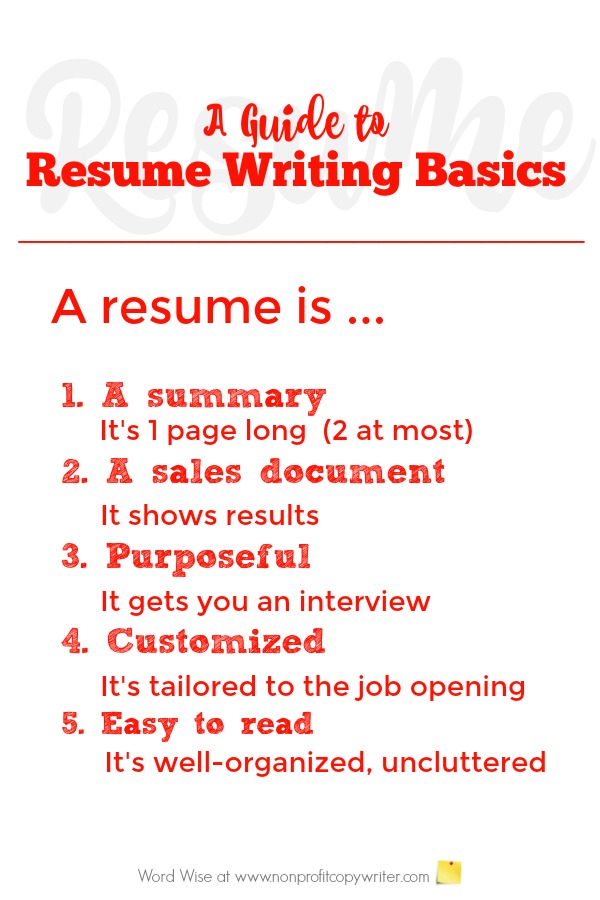
Basics About Writing Resumes
Award-winning writer Kathy Widenhouse has helped hundreds of nonprofits and writers produce successful content and has gained 600K+ views for her writing tutorials. She is the author of 9 books. See more of Kathy’s content here.
For many, writing resumes is a daunting task. But it needn’t be.
A resume is a document that summarizes your background, skills, capabilities, and experience. Together with a cover letter and application, it is one of the items submitted when applying for a job, college, scholarship, or special opportunity.
Its purpose is to capture an employer or gatekeeper’s attention and lead to a next step – in most cases, an interview. That’s why your resume is not just your calling card – it’s a sales document. A clearly-written resume paints a picture of who you are and makes you stand out.
Writing Resumes: Frequently Asked Questions (FAQs)
Q. What elements should I include in my resume?
A. Writing resumes is a fluid process. Every resume is unique. Use the following list and this free resume worksheet to gather the information you need.
- your contact information
- your employment objective
- a summary of your qualifications
- your experience
- your education
- special extras (awards, honors, special skills, profession affiliations, and publications)
Q. I’ve read there are different resume formats. Which one is right for me?
A. The two most common resume formats are chronological and functional.
- A chronological resume lists your work history in reverse chronological order, with your most recent job documented first. The main advantage of a chronological resume is that it is easy for an employer to read. This format is often used by new college graduates, those seeking entry-level positions, or workers with a consistent employment history in the same field.
- A functional resume lists your skills and experience by themes, skills, or “functions” – teaching, administration, and management, for instance. This format gives an employer a more complete view of your abilities. It is a good choice for those with more than one strong skill set or work experience in different fields. One disadvantage of a functional format is that it can be confusing for an employer to know where and when your experience took place. Be sure to make these details clear in your functional resume. A job seeker with an inconsistent employment history or experience in different fields might choose a functional format.
Depending on your experience and qualifications, you may decide to create a modified resume format, such as a qualifications/chronological resume, an accomplishments resume, or a targeted resume. The overriding principles with selecting a format are to make your resume readable, communicate how your skills and experience qualify you for the position you’re seeking, and show results. Use this quiz to see what kind of resume format is right for you.
Q. Will I need more than one resume?
A. With resumes, “one size does not fit all.” Your resume must be tailored to fit the job for which you are applying.
The key is to remember your audience – the potential employer. What is he looking for? How do your skills match what he needs? Some of your experiences are more relevant to a particular position than others. You want to communicate those that are important to that employer, and perhaps leave out others that lend little significance.
Does that mean you need to reinvent the wheel every time you send out a resume? Of course not. Start with a basic resume. Build from there.
Create a resume with the Reusable Resume Builder.
Q. I’ve got too much (or too little) information for my resume. What should I do?
A. Remember the main purpose of your resume – to get you a job interview. Use a resume worksheet to help you brainstorm your qualifications. Take that raw information and prioritize it to fit the position you are seeking. Most people are surprised to discover that they have a wealth of life experiences to tap into and share with potential employers
Q. There are so many ways to format my material. How do I know what to do?
A. Look at samples. Search for resumes in reference manuals and on the internet, particularly those from professionals in your field. Study the layout and wording. Use appropriate elements that work well with your qualifications, skills, and experience.
Q. How long should my resume be?
A. Conventional wisdom dictates that a resume be limited to one page – two at most. However, some employers (such as the federal government) have specific resume guidelines. Executive resumes often cannot be squeezed onto one sheet without appearing shallow and weak. Follow an employer’s instructions to the letter when submitting your resume. Construct your resume to be the length needed in order to sell you.
Q. What characteristics make a quality resume?
A. A top-notch resume is:
- appealing to the eye
- geared to the audience (the specific employer)
- shows results with facts and evidence
- is written in clear, concise language
- has a positive tone
- is error-free
- is honest
More Writing Resumes Tips
Create a resume with the Reusable Resume Builder...
Parts of a resume: a primer ...
Quiz: which resume writing format should you use?
3 main resume writing formats ...
Resume writing tips: easy do's and don'ts ...
Build a winning resume with a resume worksheet ...
Tips for writing resume objective ...
Writing a good cover letter: a step-by-step writing guide ...
Cover Letter Writing Tip: get the reader to take one step ...
Get more tips on our Writing Resumes Pinterest board...
Return from Basics About Writing Resumes to Nonprofit Copywriter home
As an Amazon Associate I earn from qualifying purchases.
Search This Site
Share This Page

Named to 2022 Writer's Digest list
BEST GENRE/NICHE WRITING WEBSITE


Stop Wasting Time!

Grab your exclusive FREE guide, "5 Simple Writing Tips You Can Put to Use in 10 Minutes or Less"









